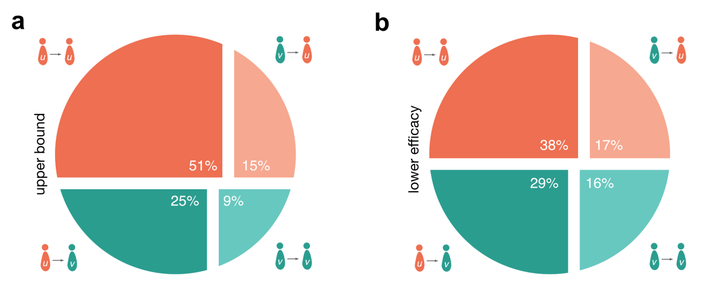New paper out: Germany’s fourth COVID-19 wave was mainly driven by the unvaccinated
Abstract
With about 65% of its citizens vaccinated at the time, Germany experienced a large wave of COVID-19 in the fall of 2021, regionally overburdening the healthcare system. We are interested in how much this crisis was driven by infections in vaccinated versus unvaccinated peo- ple. We use a mathematical model to show that transmission of the disease during this period was largely driven by the unvaccinated population, despite representing a smaller pro- portion of the overall population. Our results suggest that higher vaccine uptake, reduced mixing between vaccinated and unvaccinated people, and targeted contact-reduction mea- sures would have been effective measures to control spread at the time. These findings may have implications for how we manage future waves of COVID-19 or other diseases.

In this paper we use a recently developed approach (the contribution matrix method) in combination with epidemiological data to estimate the contribution of vaccinated and unvaccinated populations to the current COVID-19 effective reproduction number R in Germany. We find that a substantial fraction of reproduction is caused by unvaccinated individuals.
A pdf of the paper is available here.
Background
While the majority of the German population was fully vaccinated at the time (about 65%), COVID-19 incidence started growing exponentially in October 2021 with about 41% of recorded new cases aged twelve or above being symptomatic breakthrough infections, presumably also contributing to the dynamics. So far, it remained elusive how significant this contribution was and whether targeted non-pharmaceutical interventions (NPIs) may have stopped the amplification of the crisis.
Methods
We develop and introduce a contribution matrix approach based on the next-generation matrix of a population-structured compartmental infectious disease model to derive contributions of respective inter- and intragroup infection pathways of unvaccinated and vaccinated subpopulations to the effective reproduction number and new infections, considering empirical data of vaccine efficacies against infection and transmission.
Results
Here we show that about 61%–76% of all new infections were caused by unvaccinated individuals and only 24%–39% were caused by the vaccinated. Furthermore, 32%–51% of new infections were likely caused by unvaccinated infecting other unvaccinated. Decreasing the transmissibility of the unvaccinated by, e. g. targeted NPIs, causes a steeper decrease in the effective reproduction number R than decreasing the transmissibility of vaccinated individuals, potentially leading to temporary epidemic control. Reducing contacts between vaccinated and unvaccinated individuals serves to decrease R in a similar manner as increasing vaccine uptake.
Conclusions
A minority of the German population—the unvaccinated—is assumed to have caused the majority of new infections in the fall of 2021 in Germany. Our results highlight the importance of combined measures, such as vaccination campaigns and targeted contact reductions to achieve temporary epidemic control.